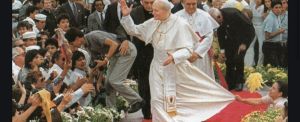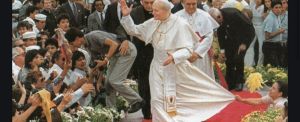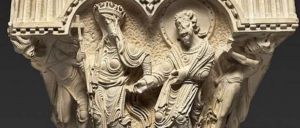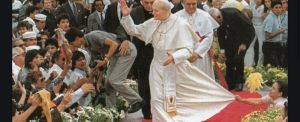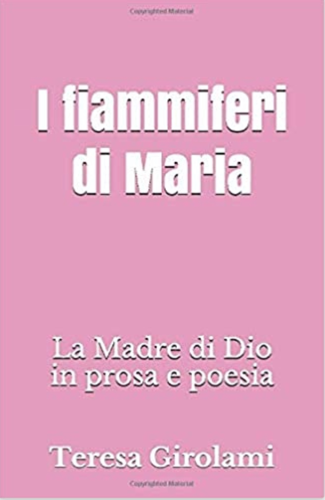
don Giuseppe Nespeca
Giuseppe Nespeca è architetto e sacerdote. Cultore della Sacra scrittura è autore della raccolta "Due Fuochi due Vie - Religione e Fede, Vangeli e Tao"; coautore del libro "Dialogo e Solstizio".
Preferential option for the poor
Today more than in the past, the Church's social doctrine must be open to an international outlook, in line with the Second Vatican Council,73 the most recent Encyclicals,74 and particularly in line with the Encyclical which we are commemorating.75 It will not be superfluous therefore to reexamine and further clarify in this light the characteristic themes and guidelines dealt with by the Magisterium in recent years.
Here I would like to indicate one of them: the option or love of preference for the poor. This is an option, or a special form of primacy in the exercise of Christian charity, to which the whole tradition of the Church bears witness. It affects the life of each Christian inasmuch as he or she seeks to imitate the life of Christ, but it applies equally to our social responsibilities and hence to our manner of living, and to the logical decisions to be made concerning the ownership and use of goods.
Today, furthermore, given the worldwide dimension which the social question has assumed,76 this love of preference for the poor, and the decisions which it inspires in us, cannot but embrace the immense multitudes of the hungry, the needy, the homeless, those without medical care and, above all, those without hope of a better future. It is impossible not to take account of the existence of these realities. To ignore them would mean becoming like the "rich man" who pretended not to know the beggar Lazarus lying at his gate (cf. Lk 16:19-31).77
Our daily life as well as our decisions in the political and economic fields must be marked by these realities. Likewise the leaders of nations and the heads of international bodies, while they are obliged always to keep in mind the true human dimension as a priority in their development plans, should not forget to give precedence to the phenomenon of growing poverty. Unfortunately, instead of becoming fewer the poor are becoming more numerous, not only in less developed countries but-and this seems no less scandalous-in the more developed ones too.
It is necessary to state once more the characteristic principle of Christian social doctrine: the goods of this world are originally meant for all.78 The right to private property is valid and necessary, but it does not nullify the value of this principle. Private property, in fact, is under a "social mortgage,"79 which means that it has an intrinsically social function, based upon and justified precisely by the principle of the universal destination of goods. Likewise, in this concern for the poor, one must not overlook that special form of poverty which consists in being deprived of fundamental human rights, in particular the right to religious freedom and also the right to freedom of economic initiative.
[Sollicitudo rei socialis n.42]
Eucharist, gratuitousness and strangers
(Lk 14:12-14)
Inviting the excluded, without a spirit of interest: the Christian community is open to everyone, especially those who have nothing to offer in return.
The Church cannot be complicit with those who turn the world into a business.
And are we really today finally learning to invite for free, not in an even more interested and mercantile way?
We are well aware that the interweaving of the computational circuits behind our actions is astounding, almost as complex as the very complicated computer circuits.
And someone is also looking for sacralization:
Before exposing ourselves in a work, we weigh with incredible rapidity all the possible relapses, the reactions useful or harmful to our interests.
Even during the course of social action, we recalibrate any changes that produce the desired effect, and at the same time the hoped compensation.
If this doesn’t come, surely we imagine that there must have been a (mechanical) fault somewhere.
If we are not careful, much of our existence is transformed into a cybernetic of interest.
It also happens with God.
Instead, it is Love that conquers the world.
It is the unconditional gift that shakes, moves, conquers; it preludes and reflects the Mystery.
In the transformation of one’s own goods into Encounter, Relationship, intimate Life and of others, the source of Joy gushes forth.
Gaiety of completeness of being, Life of the Trinity itself: different Happiness, without due or expected returns; prelude to Resurrection.
A divine existence, not behind the clouds or at the end of history, but from now on.
No reciprocation is really worth such boundless and real vertigo.
Thus the type of participants in the breaking of Bread in churches - today of an increasingly varied mentality - describes the essence of God.
The ‘polyhedron’ becomes an icon and attribute of the tolerant mercy of the Eternal.
But it is not an external or paternalistic patch; nor is it configured as a rescue of the situation [or remorse of conscience].
The condition of sin does not nullify the plan of salvation. Rather, it emphasizes the personal Exodus and the passion of things.
Different faces and circumstances become sacraments of Grace, Love so open that no human narrowness can close.
Even a non-one-way personal formation is well recalled by the thousand unusual presences of a multipolar world [as an intimate and concrete appeal].
In this way, every heterogeneous aspect is now finally appreciated as an added value, instead of being considered a “carnal” or “impurity” expression.
In short, our attitude as sisters and brothers imitates divine magnanimity: we welcome willingly and freely those who are 'different' and those without great energy or appeal.
Not because we are or they are 'good', but so that we all become good. And by being close, together, in an unforeseen, therefore vital way; overeminent one.
To internalize and live the message:
What does not elevate your relationships? and the complete sense of you?
[Monday 31st wk. in O.T. November 3, 2025]
Give back?
Among the many gifts that we buy and receive, let us not forget the true gift: to give each other something of ourselves, to give each other something of our time, to open our time to God. In this way anxiety disappears, joy is born, and the feast is created. During the festive meals of these days let us remember the Lord’s words: "When you give a dinner or a banquet, do not invite those who will invite you in return, but invite those whom no one invites and who are not able to invite you" (cf. Lk 14:12-14). This also means: when you give gifts for Christmas, do not give only to those who will give to you in return, but give to those who receive from no one and who cannot give you anything back. This is what God has done: he invites us to his wedding feast, something which we cannot reciprocate, but can only receive with joy. Let us imitate him! Let us love God and, starting from him, let us also love man, so that, starting from man, we can then rediscover God in a new way!
[Pope Benedict, homily 24 December 2006]
Deformation, dehumanisation
12. Is Justice Enough?
It is not difficult to see that in the modern world the sense of justice has been reawakening on a vast scale; and without doubt this emphasizes that which goes against justice in relationships between individuals, social groups and "classes," between individual peoples and states, and finally between whole political systems, indeed between what are called "worlds." This deep and varied trend, at the basis of which the contemporary human conscience has placed justice, gives proof of the ethical character of the tensions and struggles pervading the world.
The Church shares with the people of our time this profound and ardent desire for a life which is just in every aspect, nor does she fail to examine the various aspects of the sort of justice that the life of people and society demands. This is confirmed by the field of Catholic social doctrine, greatly developed in the course of the last century. On the lines of this teaching proceed the education and formation of human consciences in the spirit of justice, and also individual undertakings, especially in the sphere of the apostolate of the laity, which are developing in precisely this spirit.
And yet, it would be difficult not to notice that very often programs which start from the idea of justice and which ought to assist its fulfillment among individuals, groups and human societies, in practice suffer from distortions. Although they continue to appeal to the idea of justice, nevertheless experience shows that other negative forces have gained the upper hand over justice, such as spite, hatred and even cruelty. In such cases, the desire to annihilate the enemy, limit his freedom, or even force him into total dependence, becomes the fundamental motive for action; and this contrasts with the essence of justice, which by its nature tends to establish equality and harmony between the parties in conflict. This kind of abuse of the idea of justice and the practical distortion of it show how far human action can deviate from justice itself, even when it is being undertaken in the name of justice. Not in vain did Christ challenge His listeners, faithful to the doctrine of the Old Testament, for their attitude which was manifested in the words: An eye for an eye and a tooth for a tooth."111 This was the form of distortion of justice at that time; and today's forms continue to be modeled on it. It is obvious, in fact, that in the name of an alleged justice (for example, historical justice or class justice) the neighbor is sometimes destroyed, killed, deprived of liberty or stripped of fundamental human rights. The experience of the past and of our own time demonstrates that justice alone is not enough, that it can even lead to the negation and destruction of itself, if that deeper power, which is love, is not allowed to shape human life in its various dimensions. It has been precisely historical experience that, among other things, has led to the formulation of the saying: summum ius, summa iniuria. This statement does not detract from the value of justice and does not minimize the significance of the order that is based upon it; it only indicates, under another aspect, the need to draw from the powers of the spirit which condition the very order of justice, powers which are still more profound.
The Church, having before her eyes the picture of the generation to which we belong, shares the uneasiness of so many of the people of our time. Moreover, one cannot fail to be worried by the decline of many fundamental values, which constitute an unquestionable good not only for Christian morality but simply for human morality, for moral culture: these values include respect for human life from the moment of conception, respect for marriage in its indissoluble unity, and respect for the stability of the family. Moral permissiveness strikes especially at this most sensitive sphere of life and society. Hand in hand with this go the crisis of truth in human relationships, lack of responsibility for what one says, the purely utilitarian relationship between individual and individual, the loss of a sense of the authentic common good and the ease with which this good is alienated. Finally, there is the "desacralization" that often turns into "dehumanization": the individual and the society for whom nothing is "sacred" suffer moral decay, in spite of appearances.
[Pope John Paul II, Dives in Misericordia]
Free of charge
For salvation there is 'one ticket in'. But with a few caveats. First of all, it is free; and then the holders will surely be women and men who are 'in need of care and healing in body and soul'. It is easy to imagine that in the first places are 'sinners, the poor and the sick', the so-called 'last ones' in short. Celebrating Mass at Santa Marta on Tuesday, 7 November, Pope Francis revived the Gospel image - taken from the passage in Luke (14:15-24) - of the banquet to which the master of the house invites "the poor, the crippled, the blind and the lame" after the refusal of the rich who do not understand the value of the gratuitousness of salvation.
"The Gospel texts we have heard this week, these last days, are framed in a banquet," Francis was quick to point out. It is "the Lord who goes to the house of a leader of the Pharisees to dine and there he is rebuked because he does not do his ablutions". Then, the Pope continued, "during the banquet the Lord advises us not to seek the first places because there is the danger that one who is more important will come and the host will say, 'Give way to this one, move over!' That would be a disgrace."
"The passage continues," said the Pontiff, "with the advice the Lord gives to those who are to be invited to a banquet at home". And he points precisely to "those who cannot give you reciprocation, that is, those who have nothing to give you in return". Here is "the gratuitousness of the banquet". So "when he had finished explaining this, one of the diners - this is today's passage - said to Jesus, 'Blessed is he who takes food in the kingdom of God!'" The Lord "answered him with a parable, without explanation, of this man who gave a great dinner and made many guests". But "the first guests did not want to go to dinner, they cared neither about the dinner nor about the people who were there, nor about the Lord who was inviting them: they cared about other things".
And in fact one after the other they began to apologise, So, the Pope pointed out, 'the first one said to him: "I bought a field"; the other: "I bought five pairs of oxen"; another: "I got married"; but each had his own interest and this interest was greater than the invitation'. The fact is, said Francis, that 'these were attached to the interest: what can I gain? So to a free invitation the answer is: 'I don't care, maybe another day, I'm so busy, I can't go'. "Busy" but for his own "interests: busy like that man who wanted, after the harvest of grain, to make stores to enlarge his possessions. Poor man, he died that night".
These people are attached "to interest to such an extent that" they fall into "a slavery of the spirit" and "are incapable of understanding the gratuitousness of the invitation". But "if one does not understand the gratuitousness of God's invitation, one understands nothing," the Pope warned. God's initiative, in fact, "is always gratuitous: what do you have to pay to go to this banquet? The entrance ticket is to be sick, is to be poor, is to be a sinner". Precisely this 'is the ticket of entry: to be needy both in body and soul'. And 'by need', Francis reiterated, is meant 'needing care, needing healing, needing love'.
"Here," the Pontiff explained, "we see the two attitudes". God's "is always gratuitous: to save God does not charge anything, he is free". And also, Francis added, "we say the word, somewhat abstractly, 'universal'", in the sense that to the servant "the 'angry' master" says: "Go out immediately to the squares, to the streets of the city and bring in the poor, the crippled, the blind, the lame". In Matthew's other version, the master says: "good and bad: all, everyone", because "God's gratuitousness has no limits: everyone, he receives everyone".
"Instead, those who have their own interest," the Pope continued, "do not understand gratuitousness. They are like the son who stayed by his father's side when the youngest left and then, after a long time, he came back poor and the father makes feast and this one does not want to enter that feast, he does not want to enter that feast because he does not understand: "He spent all the money, he spent the inheritance, with the vices, with the sins, you make him feast? And I who am a Catholic, practical, I go to mass every Sunday, I fulfil things, nothing to me?".
The fact is that 'he does not understand the gratuitousness of salvation, he thinks that salvation is the fruit of "I pay and you save me": I pay with this, with this'. Instead "no, salvation is gratuitous". And "if you do not enter into this dynamic of gratuitousness you understand nothing".
Salvation in fact, Francis affirmed, "is a gift from God to which one responds with another gift, the gift of my heart". However, there are those 'who have other interests, when they hear about the gifts: "Yes, it is true, yes, but gifts must be given". And they immediately think: 'Here, I will give this gift and he will give me another one tomorrow and the day after'". Thus there is "always reciprocation".
Instead "the Lord asks nothing in return: only love, faithfulness, as he is love and he is faithful". Because "salvation is not bought, one simply enters the banquet: 'Blessed is he who takes food in the kingdom of God!'". And 'this is salvation'.
In fact, the Pope confided, "I ask myself: what do these people who are unwilling to come to this banquet feel? They feel secure, they feel safe, they feel saved in their own way outside the banquet". And 'they have lost the sense of gratuitousness, they have lost the sense of love and they have lost something greater and more beautiful still, and this is very bad: they have lost the capacity to feel loved'. And, he added, 'when you lose - I am not saying the capacity to love, because that can be recovered - the capacity to feel loved, there is no hope: you have lost everything'.
Moreover, the Pontiff concluded, all this 'makes us think of the words written at the door of Dante's inferno "Leave hope": you have lost everything'. On our part, we must instead look at the master of the house who wants his house to be filled: 'he is so loving that in his gratuitousness he wants to fill the house'. And so "we ask the Lord to save us from losing the capacity to feel loved".
[Pope Francis, S. Marta homily, in L'Osservatore Romano 08/11/2017]
Deceased, not "dead": they Live
Commemoration of All the Faithful Departed
On the occasion of the recent passing of my parents, to the torment of the illness and the loss of both (soon) was added the annoyance of an environment that continued to give me "condolences".
As for good manners, of course, but who has assimilated the language of the Faith does not mourn anyone, nor does he speak of "dead" but of Deceased ones. They live.
Not as survivors of the blows that life holds, but as ‘dilated’, authentic, adorned ones - and finally fully realized.
Women and men… ‘blossomed’ in everything, experiencing a new kind of being in their own essence; a different existence.
As in an atmosphere of pure love, where like Jesus we no longer live for ourselves, but one with the other and one for the other.
With no pressing chronometers, nor abandonments.
The term comes from the Latin verb «defungor» [infinitive «defungi»] which indicates the partial term of a story, not a total fulfillment.
Not a definitive border that would open on the nullifying and cavernous abyss of lost shadows or larvae without momentum, devoid of identity and future - after the transit in time.
The condolences [from the Latin «cum-dolēre»] turned willingly within a purely pagan mentality or linked to an archetypal sense of religiosity.
That kind of conviction led relatives and friends to grieve - a hopeless cry - which Jesus openly rebukes [Jn 11:33 Greek text; some translations are uncertain].
To believe that with death everything ends means to imagine that existence is a progressive decay into the void.
This conviction makes any path of growth, even spiritual, consider absurd. And it postulates the senselessness of getting involved, of committing oneself to the ideal of the lasting Good - for a Beautiful that continues beyond our earthly life and in favor of our neighbour.
“Condolences” therefore indicate in themselves that everything is over.
In the epigraph on the portal of a cemetery of a town not too far from me we read an inscription in large letters: «here over the centuries lay affections vanity hopes».
The cold of the end of all beautiful things, and the "ice" of the neoclassical revisited in early twentieth century style... perfectly matched on whitewashed travertine coating.
Instead, Hope attracts us and refreshes the spirit, overcomes outrage, gives meaning to our going.
Already the believers of the first centuries had supplanted the pagan idea of the appointment of our sister death as «dies infaustus», replacing it in its opposite: «dies Natalis».
Day of true Birth, within the same Life now complete, healed.
Life, which precisely proceeds - beyond the temporal or locality parameters.
Without the fatigue of existing that we experience. Immersed in the vastness of being.
Life without the struggles against oneself, and which continues in the satisfying, blessing Embrace of a Father who does not depersonalize but expands the character existence, the qualities of his sons.
In this blossoming full of light and warmth we are as if we were refounded on the prototype-Project of the authentic Son.
Alliance Trait that we should and perhaps could have been.
Overwhelmed ones with blissful Happiness, for our shadow-part is now included; devoid of judgments and comments.
[Commemoration of All the Faithful Departed, November 2]
Deceased, not "dead": they live
(Commemoration of All the Faithful Deceased)
"I see these fearful spaces of the universe surrounding me, and I find myself attached to a corner of this immensity, without knowing why I am placed in this place rather than in another, nor why the little time that is given to me to live is assigned to me at this point rather than in another from all the eternity that has preceded me and from all the eternity that succeeds me. I see nothing but infinite extensions on all sides, enclosing me like an atom and like a shadow that lasts but an instant without return. All I know is that I must soon die; but what I most ignore is this death itself, from which I cannot escape" [Pascal, Pensées, 194].
On the occasion of my parents' recent passing, the heartbreak of illness and the loss of both of them (soon) was compounded by the annoyance of an environment that kept on giving me 'condolences'.
As out of good manners, of course, but those who have assimilated the language of the Faith do not offer condolences, nor do they speak of 'the dead' but of the departed. They live.
Not as survivors of the blows that life has in store, but as fully realised, authentic, adorned gods.
Women and men blossomed into everything, who have experienced a new kind of being in their essence, a different kind of existence.
As in an atmosphere of pure love, where (like Jesus) one no longer lives for oneself, but one with the other and one for the other.
Without the pressing chronometers, nor the abandonments.
The term defunct comes from the Latin verb 'defungor' [infinitive 'defungi'] which indicates the partial end of an event, not a total fulfilment.
Not a definitive boundary that would open on the nullifying and cavernous abyss of lost shadows or larvae without momentum, devoid of identity and future - after transit through time.
Condolences' [from the Latin 'cum-dolēre'] were willingly offered within a purely pagan mentality or linked to an archetypal sense of religiosity.
That kind of conviction induced in relatives and friends an affliction - a hopeless weeping - that Jesus openly reproaches [John 11,33 Greek text; the Italian translation is uncertain].
To believe that with death everything ends is to imagine that existence is a progressive decay into emptiness.
Such a belief makes any path of growth, even spiritual growth, seem absurd. And it postulates the absurdity of involving oneself, of committing oneself to the ideal of lasting Good - to a Good that continues beyond our earthly vicissitude (and in favour of our neighbour).
The condolences thus stand for themselves to indicate that all is over.
An epigraph on the portal of a cemetery in a town not too far from me reads in large letters: 'here in the centuries lay affections vanities hopes'.
The cold of the end of all beautiful things, and the 'ice' of the neoclassical revisited in early 20th century style... perfectly matched on whitewashed travertine cladding.
Instead, Hope attracts us and refreshes the spirit, overcomes outrage, gives meaning to our going.
Already the believers of the first centuries had supplanted the pagan idea of the appointment of our sister death as 'dies infaustus', replacing it with its opposite: 'dies Natalis'.
Day of the true Birth, within the same Life; now complete, restored.
Life, which indeed continues - beyond the parameters of time or location.
Without the fatigue of existing that we experience. Immersed in the vastness of being.
Life without the struggles against self, and which continues in the satisfying, blessing embrace of a Father who does not depersonalise but dilates the character existence, the qualities of his children.
In such a blossoming full of light and warmth we are as if refounded on the prototype-Project of the authentic Son.
Covenant trait that we were meant to be and perhaps could be.
Overwhelmed with blissful Happiness, because our shadow-part is now included; free of judgement and commentary.
In "Hope of the Mustard Wheat" we read a gem by Joseph Ratzinger, who had the guts to write words to be seriously carved on the friezes of entablatures (in place of other superficialities for effect - unfortunately widespread):
"Today it seems clear that the fire of Judgement of which the Bible speaks does not indicate some kind of prison of the afterlife, but rather the Lord Himself who at the moment of judgement meets with man [...]".
"In the man who presents himself to the gaze of the Lord, everything in his life that is 'straw and hay' burns away and only that which can really have substance remains. And it means that through the encounter with Christ, man is recast and reshaped according to what he was meant to be and could properly be. The fundamental option of such a man is the Yes that makes him capable of accepting God's mercy; but this fundamental decision is many times numbed and shrivelled, it only peeps out with difficulty from the shackles of selfishness from which man has never been able to free himself. The encounter with the Lord is this transformation, the fire that burns and melts him, making him become that figure, that form without dross that can become the vessel of eternal Joy.
The fire that burns: Christ himself
Some recent theologians are of the opinion that the fire that both burns and saves is Christ Himself, the Judge and Saviour. The encounter with Him is the decisive act of Judgement. Before His gaze all falsehood melts away. It is the encounter with Him that, by burning us, transforms us and frees us to become truly ourselves. The things built up during life can then turn out to be dry straw, empty boasting and collapse. But in the pain of this encounter, in which the impure and unhealthy in our being become evident to us, lies salvation. His gaze, the touch of his heart heals us through a transformation that is certainly painful 'as through fire'. It is, however, a blessed sorrow, in which the holy power of his love penetrates us like a flame, enabling us in the end to be totally ourselves and thereby totally of God. Thus the interpenetration of righteousness and grace is also made evident: our way of life is not irrelevant, but our filthiness does not stain us eternally, if at least we have remained inclined towards Christ, towards truth and towards love. After all, this filth has already been burnt away in the Passion of Christ. At the moment of Judgement we experience and embrace this prevailing of his love over all evil in the world and in us. The pain of love becomes our salvation and our joy. It is clear that the "duration" of this transforming burning cannot be calculated by the chronometric measures of this world. The transforming "moment" of this encounter eludes earthly timing - it is time of the heart, time of the "passage" to communion with God in the Body of Christ. The Judgement of God is hope both because it is justice and because it is grace. If it were merely grace that renders all that is earthly irrelevant, God would remain indebted to us for the answer to the question of justice - a question that is decisive for us before history and God himself. If it were pure justice, it could in the end only be a cause for fear for all of us. The incarnation of God in Christ has so linked the one with the other - judgement and grace - that justice is firmly established: we all await our salvation "with fear and trembling" (Phil 2:12). Nevertheless, grace enables us all to hope and to go full of confidence towards the Judge whom we know as our "advocate", parakletos (cf. 1 Jn 2:1).
[Pope Benedict, Encyclical Spe Salvi no.47]
Unknown known reality
12. I think that in this very precise and permanently valid way, Augustine is describing man's essential situation, the situation that gives rise to all his contradictions and hopes. In some way we want life itself, true life, untouched even by death; yet at the same time we do not know the thing towards which we feel driven. We cannot stop reaching out for it, and yet we know that all we can experience or accomplish is not what we yearn for. This unknown “thing” is the true “hope” which drives us, and at the same time the fact that it is unknown is the cause of all forms of despair and also of all efforts, whether positive or destructive, directed towards worldly authenticity and human authenticity. The term “eternal life” is intended to give a name to this known “unknown”. Inevitably it is an inadequate term that creates confusion. “Eternal”, in fact, suggests to us the idea of something interminable, and this frightens us; “life” makes us think of the life that we know and love and do not want to lose, even though very often it brings more toil than satisfaction, so that while on the one hand we desire it, on the other hand we do not want it. To imagine ourselves outside the temporality that imprisons us and in some way to sense that eternity is not an unending succession of days in the calendar, but something more like the supreme moment of satisfaction, in which totality embraces us and we embrace totality—this we can only attempt. It would be like plunging into the ocean of infinite love, a moment in which time—the before and after—no longer exists. We can only attempt to grasp the idea that such a moment is life in the full sense, a plunging ever anew into the vastness of being, in which we are simply overwhelmed with joy. This is how Jesus expresses it in Saint John's Gospel: “I will see you again and your hearts will rejoice, and no one will take your joy from you” (16:22). We must think along these lines if we want to understand the object of Christian hope, to understand what it is that our faith, our being with Christ, leads us to expect.
[Pope Benedict, Spe salvi]
Mystery of death: not the last word on human fate
Dear Brothers and Sisters,
1. After having celebrated yesterday the Solemnity of All Saints, today, 2 November, our prayerful gaze is directed toward those who have departed from this world and are awaiting arrival into the Heavenly City. The Church has always strongly advised that we pray for the dead. She invites believers to regard the mystery of death not as the "last word" of human destiny but rather as a passage to eternal life. As we read in the Preface of today's Mass: "When the body of our earthly dwelling lies in death we gain an everlasting dwelling place in heaven".
2. It is an important obligation to pray for the dead, because even if they have died in grace and in God's friendship, they may still need final purification in order to enter the joy of Heaven (cf. Catechism of the Catholic Church, n. 1030). Prayer for the dead is expressed in various ways, one of which is also visiting the cemeteries. Pausing in these sacred places becomes an ideal occasion to reflect on the meaning of earthly life and at the same time to nourish hope in the blessed eternity of Paradise.
May Mary, Gate of Heaven, help us never to forget and never to lose sight of the Heavenly Homeland, the final destination of our pilgrimage here on earth.
[Pope John Paul II, Angelus 2 November 2003]
Defeat and Hope
Job, defeated, or rather, at the end of his life due to illness, with his skin stripped away, nearly at the point of death, almost without flesh, Job has a certitude and he states it: “I know that my Redeemer lives, and at last he will stand upon the earth” (Jb 19:25). At the moment in which Job is at his very lowest, there is that embrace of light and warmth that reassures him: I will see the Redeemer. I will see him with these eyes. “I shall see God, whom I shall see on my side, and my eyes shall behold, and not another” (19:26-27).
This certainty, precisely at nearly the final moment of life, is Christian hope. It is a hope that is a dream: we cannot have it. It is a gift we must ask for: ‘Lord, give me hope’. There are many bad things that lead us to despair, to believe that all will be a definitive loss, that after death there will be nothing... And Job’s voice returns; it returns: “I know that my Redeemer lives, and at last he will stand upon the earth... I shall see God, whom I shall see on my side”, with these eyes.
“Hope does not disappoint” (Rom 5:5), Paul told us. Hope draws us and gives meaning to our life. I do not see the afterlife, but hope is God’s gift that draws us toward life, toward eternal joy. Hope is an anchor that we have from the other side, and we, grasping the rope, sustain ourselves (cf. Heb 6:18-19). ‘I know that my Redeemer lives, and I shall see him’. And repeat this in times of joy and in bad times, in times of death, let us say this.
This certitude is a gift of God, because we can never have hope by our own efforts. We must ask for it. Hope is a freely given gift that we never deserve: it is given; it is offered. It is grace.
And then, the Lord confirms this, this hope that does not disappoint. “All that the Father gives me will come to me” (Jn 6:37). This is the aim of hope: to go to Jesus. And “him who comes to me I will not cast out. For I have come down from heaven, not to do my own will, but the will of him who sent me” (Jn 6:37-38). The Lord who welcomes us there, where the anchor lies. Life in hope is to live like this: grasping, with the rope in hand, strong, knowing that the anchor is below. And this anchor does not disappoint; it does not disappoint.
Today, in the thoughts of many brothers and sisters who have passed on, it will do us good to look at the cemeteries and to look heavenward. And to repeat, like Job: ‘I know that my Redeemer lives, and I myself will see him. My eyes shall behold him, and not another’. And this is the strength that hope gives us, this freely given gift that is the virtue of hope. May the Lord give it to all of us.
[Pope Francis, homily 2 November 2020]
Christianity cannot be, cannot be exempt from the cross; the Christian life cannot even suppose itself without the strong and great weight of duty [Pope Paul VI]
Il Cristianesimo non può essere, non può essere esonerato dalla croce; la vita cristiana non può nemmeno supporsi senza il peso forte e grande del dovere [Papa Paolo VI]
The horizon of friendship to which Jesus introduces us is the whole of humanity [Pope Benedict]
L’orizzonte dell’amicizia in cui Gesù ci introduce è l’umanità intera [Papa Benedetto]
However, the equality brought by justice is limited to the realm of objective and extrinsic goods, while love and mercy bring it about that people meet one another in that value which is man himself, with the dignity that is proper to him (Dives in Misericordia n.14)
L'eguaglianza introdotta mediante la giustizia si limita però all’ambito dei beni oggettivi ed estrinseci, mentre l'amore e la misericordia fanno si che gli uomini s'incontrino tra loro in quel valore che è l'uomo stesso, con la dignità che gli è propria (Dives in Misericordia n.14)
The Church invites believers to regard the mystery of death not as the "last word" of human destiny but rather as a passage to eternal life (Pope John Paul II)
La Chiesa invita i credenti a guardare al mistero della morte non come all'ultima parola sulla sorte umana, ma come al passaggio verso la vita eterna (Papa Giovanni Paolo II)
The saints: they are our precursors, they are our brothers, they are our friends, they are our examples, they are our lawyers. Let us honour them, let us invoke them and try to imitate them a little (Pope Paul VI)
I santi: sono i precursori nostri, sono i fratelli, sono gli amici, sono gli esempi, sono gli avvocati nostri. Onoriamoli, invochiamoli e cerchiamo di imitarli un po’ (Papa Paolo VI)
Man rightly fears falling victim to an oppression that will deprive him of his interior freedom, of the possibility of expressing the truth of which he is convinced, of the faith that he professes, of the ability to obey the voice of conscience that tells him the right path to follow [Dives in Misericordia, n.11]
L'uomo ha giustamente paura di restar vittima di una oppressione che lo privi della libertà interiore, della possibilità di esternare la verità di cui è convinto, della fede che professa, della facoltà di obbedire alla voce della coscienza che gli indica la retta via da seguire [Dives in Misericordia, n.11]
We find ourselves, so to speak, roped to Jesus Christ together with him on the ascent towards God's heights (Pope Benedict)
Ci troviamo, per così dire, in una cordata con Gesù Cristo – insieme con Lui nella salita verso le altezze di Dio (Papa Benedetto)
Church is a «sign». That is, those who looks at it with a clear eye, those who observes it, those who studies it realise that it represents a fact, a singular phenomenon; they see that it has a «meaning» (Pope Paul VI)
La Chiesa è un «segno». Cioè chi la guarda con occhio limpido, chi la osserva, chi la studia si accorge ch’essa rappresenta un fatto, un fenomeno singolare; vede ch’essa ha un «significato» (Papa Paolo VI)
Let us look at them together, not only because they are always placed next to each other in the lists of the Twelve (cf. Mt 10: 3, 4; Mk 3: 18; Lk 6: 15; Acts 1: 13), but also because there is very little information about them, apart from the fact that the New Testament Canon preserves one Letter attributed to Jude Thaddaeus [Pope Benedict]
duevie.art
don Giuseppe Nespeca
Tel. 333-1329741
Disclaimer
Questo blog non rappresenta una testata giornalistica in quanto viene aggiornato senza alcuna periodicità. Non può pertanto considerarsi un prodotto editoriale ai sensi della legge N°62 del 07/03/2001.
Le immagini sono tratte da internet, ma se il loro uso violasse diritti d'autore, lo si comunichi all'autore del blog che provvederà alla loro pronta rimozione.
L'autore dichiara di non essere responsabile dei commenti lasciati nei post. Eventuali commenti dei lettori, lesivi dell'immagine o dell'onorabilità di persone terze, il cui contenuto fosse ritenuto non idoneo alla pubblicazione verranno insindacabilmente rimossi.


